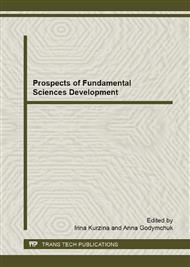p.335
p.340
p.345
p.351
p.357
p.363
p.370
p.376
p.384
Comparative Study of the Biological Efficacy of Titanium Dioxide Nano- and Microparticles
Abstract:
Chronic experiments with male Wistar rats were carried out to investigate the delayed effects of oral administration of titanium dioxide nanoand microparticles on the integral indices of the body condition and level of the oxidative stress. It was found that the studied titanium dioxide (TiO2) particles produced different effects on the indicated characteristics: on the 7th day after the experiment, the animal bodyweight decreased in both experimental groups as compared to control; weight factors in the brain and testicles of the rats fed with TiO2 microparticles increased with respect to control group and to the group of rats fed with TiO2 nanoparticles; the oxidative stress developed in the group of rats fed with TiO2 microparticles because the level of oxidized products increased in the brain (cerebellum) and antioxidant ability of the tissue decreased in the liver. In the group of rats fed with TiO2 nanoparticles, no changes in the level of oxidized products and antioxidant ability in the body tissues were found in comparison with control group on the 7th day after the experiment. Thus, in the study of biological effects of TiO2 nanoparticles, an additional control with investigation of TiO2 macro-or microparticles is necessary, because TiO2 microparticles were shown to have the biological efficacy.
Info:
Periodical:
Pages:
357-362
Citation:
Online since:
February 2015
Authors:
Price:
Сopyright:
© 2015 Trans Tech Publications Ltd. All Rights Reserved
Share:
Citation:


